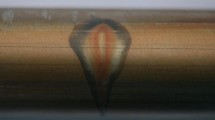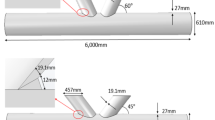Abstract
The objective of this study is to quantitatively analyze the static and fatigue characteristics of the repeated welding, operating temperatures, and surface defects (notches) in tubes with Al3003-O aluminum, which is applied to the heat exchangers. In particular, fatigue characteristics on actual aluminum tubes are evaluated. It was confirmed the grain size increases and the hardness decreases due to changes in the internal structure as the number of repeated welding increases. The fatigue limit of the aluminum tube at the operating temperature was 49.02 MPa which was lower than the room temperature. Also, the fatigue limit of the notched aluminum tube is measured to be 29.37 MPa which is reduced compared to that of the specimens without a notch; the fatigue notch factor is 1.67. Based on the Peterson equation, the material constants were derived by combining the results (fatigue notch factor, etc.) obtained through analysis and experiments. Derived material constants allow the prediction of fatigue limits for various defect (notch) sizes that may occur during the manufacturing and assembly of the heat exchanger.










Similar content being viewed by others
References
Karamış, M. B., Taşdemirci, A., & Nair, F. E. H. M. İ. (2003). Microstructural analysis and discontinuities in the brazed zone of copper tubes. Journal of Materials Processing Technology, 141(3), 302–312.
Ando, T., Tamagawa, H., & Shohji, I. (2010). Cu–Sn–Zr–P alloy for a high-strength heat-exchanger tube. Transactions of The Japan Institute of Electronics Packaging, 3(1), 14–17.
Shirai, T., & Saeki, C. (2004). Development of high strength, heat resistant KHRT copper alloy tube. Research and Development-Kobe, 54(1), 78–82.
Yang, Y. J., & Lee, C. M. (2021). A study on the optimization of joint mandrel shape for manufacturing long type elbow using push bending process. International Journal of Precision Engineering and Manufacturing, 22, 431–439.
Sajuri, Z., Baghdadi, A., Mahmod, M. F., & Syarif, J. (2014). Fatigue and mechanical properties of aluminium-copper bi-metal tubes. In Advanced Materials Research (Vol. 896, pp. 626–629). Trans Tech Publications Ltd.
Wang, S., Cheng, S., Yu, H., Rao, Z., & Liu, Z. (2013). Experimental investigation of Al–Cu composed tube–fin heat exchangers for air conditioner. Experimental thermal and fluid science, 51, 264–270.
Kim, S. H., Lee, S. G., Park, J. M., Park, J. H., & Lee, M. H. (2018). A Study on Galvanic Corrosion properties between differential Al Alloys. In Proceedings of the Korean Institute of Surface Engineering Conference (pp. 96–96). The Korean Institute of Surface Engineering.
Liu, Y., Gong, H., He, Y., Zhang, T., Sun, Y., & Liu, X. (2022). Research on machining deformation of 7050 aluminum alloy aircraft rib forging. International Journal of Precision Engineering and Manufacturing, 23(5), 533–543.
Ferreira, V., Egizabal, P., Popov, V., de Cortázar, M. G., Irazustabarrena, A., López-Sabirón, A. M., & Ferreira, G. (2019). Lightweight automotive components based on nanodiamond-reinforced aluminium alloy: A technical and environmental evaluation. Diamond and Related Materials, 92, 174–186.
Li, X., Chen, Y., Lang, L., & Xiao, R. (2021). A modified mk method for accurate prediction of flc of aluminum alloy. Metals, 11(3), 394.
Ma, Z. L., Zhang, J. L., & Li, D. F. (2003). Some problems of copper using in air conditioning and refrigeration system. Refrigeration and Air Conditioning, 3, 66–70.
Khosravifard, A., & Ebrahimi, R. (2010). Investigation of parameters affecting interface strength in Al/Cu clad bimetal rod extrusion process. Materials & Design, 31(1), 493–499.
Hwang, S. H., Kim, H. G., Seon, C. Y., Lee, C. S., & Lee, B. Y. (2010). Fatigue life evaluation for HP drum in HRSG according to EN code. In Proceedings of KSME autumn conference (pp. 506–511).
Kim, T. H., Choi, J. S., & Han, J. S. (2017). Thermal-structural analysis and fatigue life evaluation of a parallel slide gate valve in accordance with ASME B&PVC. Transactions of the Korean Society of Mechanical Engineers A, 41(2), 157–164.
Yim, H. J., & Lee, S. B. (1996). An integrated CAE system for dynamic stress and fatigue life prediction of mechanical systems. KSME Journal, 10(2), 158–168.
Lee, S. B., Park, T. W., Park, J. S., Lee, S. B., & Yim, H. J. (2000). A study on computational method for fatigue life prediction of vehicle structures. In Proceedings of the Korean society for noise and vibration engineering conference (pp. 1883–1888). The Korean Society for Noise and Vibration Engineering.
Yoon, H. Y., & Zhang, J. (2008). Evaluation for probabilistic distributions of fatigue life of marine propeller materials by using a Monte Carlo simulation. Transactions of the Korean Society of Mechanical Engineers A, 32(12), 1055–1062.
Kim, D. S., & Kim, J. K. (1994). The prediction of fatigue life according to the determination of the parameter in residual strength degradation model. Transactions of the KSME, 18(8), 2053–2061.
Qiao, H., & Hao, X. (1995). Two-parameter nominal stress approach. International Journal of Fatigue, 17(5), 339–341.
Ling, J., & Pan, J. (1998). A new method for selection of population distribution and parameter estimation. Reliability Engineering & System Safety, 60(3), 247–255.
Seok, C. S., Park, J. S., Kim, H. I., Lee, Y. M., Cho, W. H., & Song, W. K. (2005). Evaluation of fatigue characteristic of a real waterworks pipe. In Key engineering materials (Vol. 297, pp. 2471–2476). Trans Tech Publications Ltd.
Choi, J. H., Koo, J. M., Seok, C. S., & Song, W. K. (2008). Evaluation of fatigue life characteristic of a real waterwork pipe using the probability density function. Transactions of the Korean Society of Mechanical Engineers A, 32(9), 707–712.
Lee, T. S., & Yang, H. T. (1997). A research of effect on fatigue life by residual stress at welds of pipe. Korea Welding Society Special Lecture and Conference Presentation Overview, 74–77
Mun, J. M., Jeong, Y. S., Jeon, J. H., Ahn, J. H., & Kim, I. T. (2017). Experimentally evaluating fatigue behavior of corroded steels exposed in atmospheric environments. Journal of Korean Society of Steel Construction, 29(3), 193–204.
Rusnak, C. R., & Menzemer, C. C. (2021). Fatigue behavior of nonreinforced hand-holes in aluminum light poles. Metals, 11(8), 1222.
Gerber, D. A. (1998). Evaluation of environmental fatigue effects for a Westinghouse nuclear power plant. EPRI Report No TR-110043.
Wilson, M., & Bowers, C. D. (2014). Design of accelerated fatigue tests for flame free refrigeration fittings.
Elbel, S., Duggan, M., LaGrotta, T., Raj, S., & Hrnjak, P. (2016). Accelerated fatigue testing of aluminum refrigeration press fittings for HVAC & R applications.
Kim, K. J., & Chung, S. C. (2002). An Effect of warm shot peening on the fatigue behavior of suspension coil springs. Transactions of the Korean Society of Mechanical Engineers A, 26(6), 1209–1216.
Heo, C. Y., An, D. W., Won, J. H., & Choi, J. H. (2011). Inverse estimation of fatigue life parameters of springs based on the bayesian approach. Transactions of the Korean Society of Mechanical Engineers A, 35(4), 393–400.
Standard, A. S. T. M. (1996). E112: Standard test methods for determining average grain size. West Conshocken, 112, 4–20.
Hansen, N. (2004). Hall-Petch relation and boundary strengthening. Scripta Materialia, 51(8), 801–806.
Pande, C. S., & Cooper, K. P. (2009). Nanomechanics of Hall-Petch relationship in nanocrystalline materials. Progress in Materials Science, 54(6), 689–706.
Pilkey, W. D., Pilkey, D. F., & Bi, Z. (2020). Peterson’s stress concentration factors. Wiley.
Acknowledgements
This research is supported by Basic Science Research Program through the National Research Foundation of Korea (NRF) funded by the Ministry of Education (NRF-2021R1I1A3044394, PI: Prof. Jaehyeok Doh).
Author information
Authors and Affiliations
Corresponding authors
Ethics declarations
Conflict of interest
On behalf of all the authors, the corresponding author states that there is no conflict of interest.
Additional information
Publisher's Note
Springer Nature remains neutral with regard to jurisdictional claims in published maps and institutional affiliations.
Rights and permissions
Springer Nature or its licensor (e.g. a society or other partner) holds exclusive rights to this article under a publishing agreement with the author(s) or other rightsholder(s); author self-archiving of the accepted manuscript version of this article is solely governed by the terms of such publishing agreement and applicable law.
About this article
Cite this article
Han, C., Doh, J. Investigation of Fatigue Characteristics for Heat Exchanger Tube in Air Conditioner: Effect of Surface Defect and Environmental Factor. Int. J. Precis. Eng. Manuf. 24, 867–875 (2023). https://doi.org/10.1007/s12541-023-00793-9
Received:
Revised:
Accepted:
Published:
Issue Date:
DOI: https://doi.org/10.1007/s12541-023-00793-9




